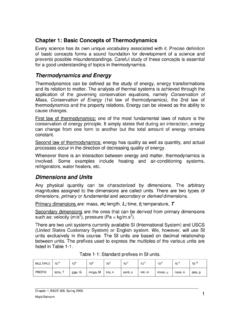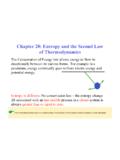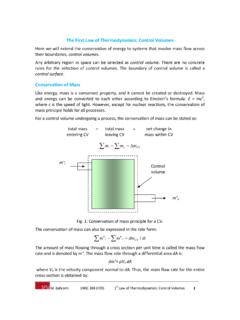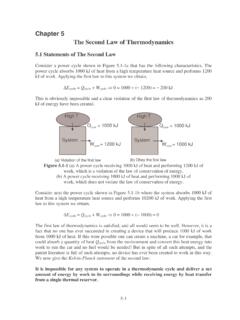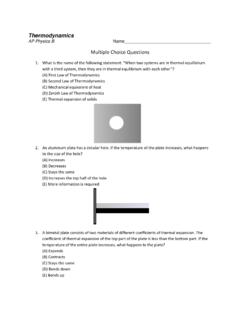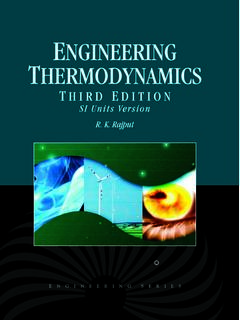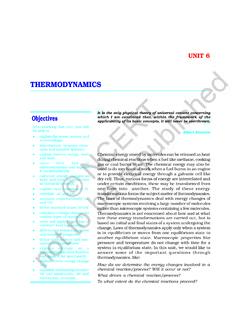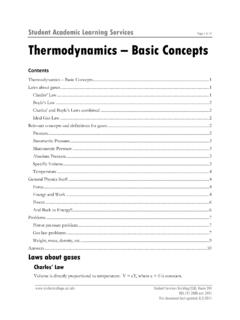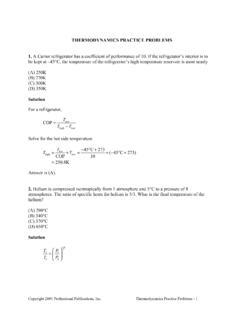Transcription of UNIT 61: ENGINEERING THERMODYNAMICS
1 1 unit 61: ENGINEERING THERMODYNAMICS unit code: D/601/1410 QCF level: 5 Credit value: 15 OUTCOME 1 TUTORIAL No. 2 THERMODYNAMIC SYSTEMS 1. Understand the parameters and characteristics of thermodynamic systems Polytropic processes: general equation pvn=c, relationships between index `n' and heat transfer during a process; constant pressure and reversible isothermal and adiabatic processes; expressions for work flow Thermodynamic systems and their properties: closed systems; open systems; application of first law to derive system energy equations; properties; intensive; extensive; two-property rule Relationships: R = cp cv. and = cp/cv When you have completed this tutorial you should be able to do the following.
2 Explain and use the First Law of THERMODYNAMICS . Solve problems involving various kinds of thermodynamic systems. Explain and use polytropic expansion and compression processes. 2 1. ENERGY TRANSFER There are two ways to transfer energy in and out of a system, by means of work and by means of heat. Both may be regarded as a quantity of energy transferred in Joules or energy transfer per second in Watts. When you complete section one you should be able to explain and calculate the following. Heat transfer. Heat transfer rate. Work transfer Work transfer rate (Power) HEAT TRANSFER Heat transfer occurs because one place is hotter than another. Under normal circumstances, heat will only flow from a hot body to a cold body by virtue of the temperature difference.
3 There are 3 mechanisms for this, Conduction, convection and radiation. You do not need to study the laws governing conduction, convection and radiation in this module. A quantity of energy transferred as heat is given the symbol Q and it's basic unit is the Joule. The quantity transferred in one second is the heat transfer rate and this has the symbol and the unit is the Watt. An example of this is when heat passes from the furnace of a steam boiler through the walls separating the combustion chamber from the water and steam. In this case, conduction, convection and radiation all occur together. 3 SELF ASSESSMENT EXERCISE 1. 1 kg/s of steam flows in a pipe 40 mm bore at 200 bar pressure and 400oC.
4 I. Look up the specific volume of the steam and determine the mean velocity in the pipe. ( m/s) ii. Determine the kinetic energy being transported per second. ( W) iii. Determine the enthalpy being transported per second. (2819 W) 4 WORK TRANSFER Energy may be transported from one place to another mechanically. An example of this is when the output shaft of a car engine transfers energy to the wheels. A quantity of energy transferred as work is 'W' Joules but the work transferred in one second is the Power 'P' Watts. An example of power transfer is the shaft of a steam turbine used to transfer energy from the steam to the generator in an electric power station. It is useful to remember that the power transmitted by a shaft depends upon the torque and angular velocity.
5 The formulae used are P = T or P = 2 NT is the angular velocity in radian per second and N is the angular velocity in revolutions per second. 5 WORKED EXAMPLE No. 1 A duct has a cross section of m x m. Steam flows through it at a rate of 3 kg/s with a pressure of 2 bar. The steam has a dryness fraction of Calculate all the individual forms of energy being transported. SOLUTION Cross sectional area = x = m2. Volume flow rate = mxvg at 2 bar Volume flow rate = 3 x x = m3/s. velocity = c = Volume/area = = m/s. Kinetic Energy being transported = mc2/2 = 3 x /2 = 1 584 Watts. Enthalpy being transported = m(hf + x hfg) H= 3(505 + x 2202) = Flow energy being transported = pressure x volume Flow Energy = 2x105 x = 520 000 Watts Internal energy being transported = m(uf + x ufg) U = 3(505 + x 2025)= kW Check flow energy = H - U = - = 520 kW 6 SELF ASSESSMENT EXERCISE 1.
6 The shaft of a steam turbine produces 600 Nm torque at 50 rev/s. Calculate the work transfer rate from the steam. ( W) 2. A car engine produces 30 kW of power at 3000 rev/min. Calculate the torque produced. ( Nm) 7 2. THE FIRST LAW OF THERMODYNAMICS When you have completed section two, you should be able to explain and use the following terms. The First Law of THERMODYNAMICS . Closed systems. The Non-Flow Energy Equation. Open systems. The Steady Flow Energy Equation. THERMODYNAMIC SYSTEMS In order to do energy calculations, we identify our system and draw a boundary around it to separate it from the surroundings. We can then keep account of all the energy crossing the boundary.
7 The first law simply states that The nett energy transfer = nett energy change of the system. Fig. 4 Energy transfer into the system = E(in) Energy transfer out of system = E (out) Nett change of energy inside system = E(in) - E (out) = E This is the fundamental form of the first law. Thermodynamic systems might contain only static fluid in which case they are called NON-FLOW or CLOSED SYSTEMS. Alternatively, there may be a steady flow of fluid through the system in which case it is known as a STEADY FLOW or OPEN SYSTEM. The energy equation is fundamentally different for each because most energy forms only apply to a fluid in motion. We will look at non-flow systems first. 8 NON-FLOW SYSTEMS The rules governing non-flow systems are as follows.
8 The volume of the boundary may change. No fluid crosses the boundary. Energy may be transferred across the boundary. When the volume enlarges, work (-W) is transferred from the system to the surroundings. When the volume shrinks, work (+W) is transferred from the surroundings into the system. Energy may also be transferred into the system as heat (+Q) or out of the system (-Q). This is best shown with the example of a piston sliding inside a cylinder filled with a fluid such as gas. The only energy possessed by the fluid is internal energy (U) so the net change is U. The energy equation becomes Q + W = U This is known as the NON-FLOW ENERGY EQUATION ( ) 9 STEADY FLOW SYSTEMS The laws governing this type of system are as follows.
9 Fluid enters and leaves through the boundary at a steady rate. Energy may be transferred into or out of the system. A good example of this system is a steam turbine. Energy may be transferred out as a rate of heat transfer or as a rate of work transfer P. The fluid entering and leaving has potential energy (PE), kinetic energy (KE) and enthalpy (H). The first law becomes + P = Nett change in energy of the fluid. + P = (PE)/s + (KE)/s + (H)/s This is called the STEADY FLOW ENERGY EQUATION ( ) Again, we will use the convention of positive for energy transferred into the system. Note that the term means change of and if the inlet is denoted point (1) and the outlet point (2).
10 The change is the difference between the values at (2) and (1). For example H means (H2-H1). 10 WORKED EXAMPLE A steam turbine is supplied with 30 kg/s of superheated steam at 80 bar and 400oC with negligible velocity. The turbine shaft produces 200 kNm of torque at 3000 rev/min. There is a heat loss of MW from the casing. Determine the thermal power remaining in the exhaust steam. SOLUTION Shaft Power = 2 NT =2 (3000/60) x 200 000 = x 106 W = MW Thermal power supplied = H at 80 bar and 400oC H = 30(3139) = 94170 kW = MW Total energy flow into turbine = MW Energy flow out of turbine = MW = SP + Loss + Exhaust. Thermal Power in exhaust = - = MW SELF ASSESSMENT EXERCISE 1.










